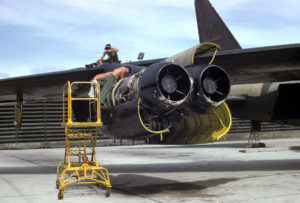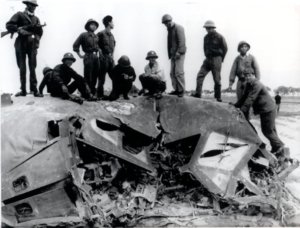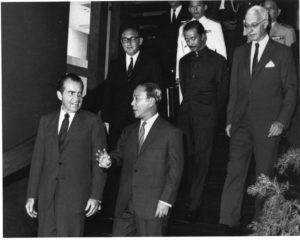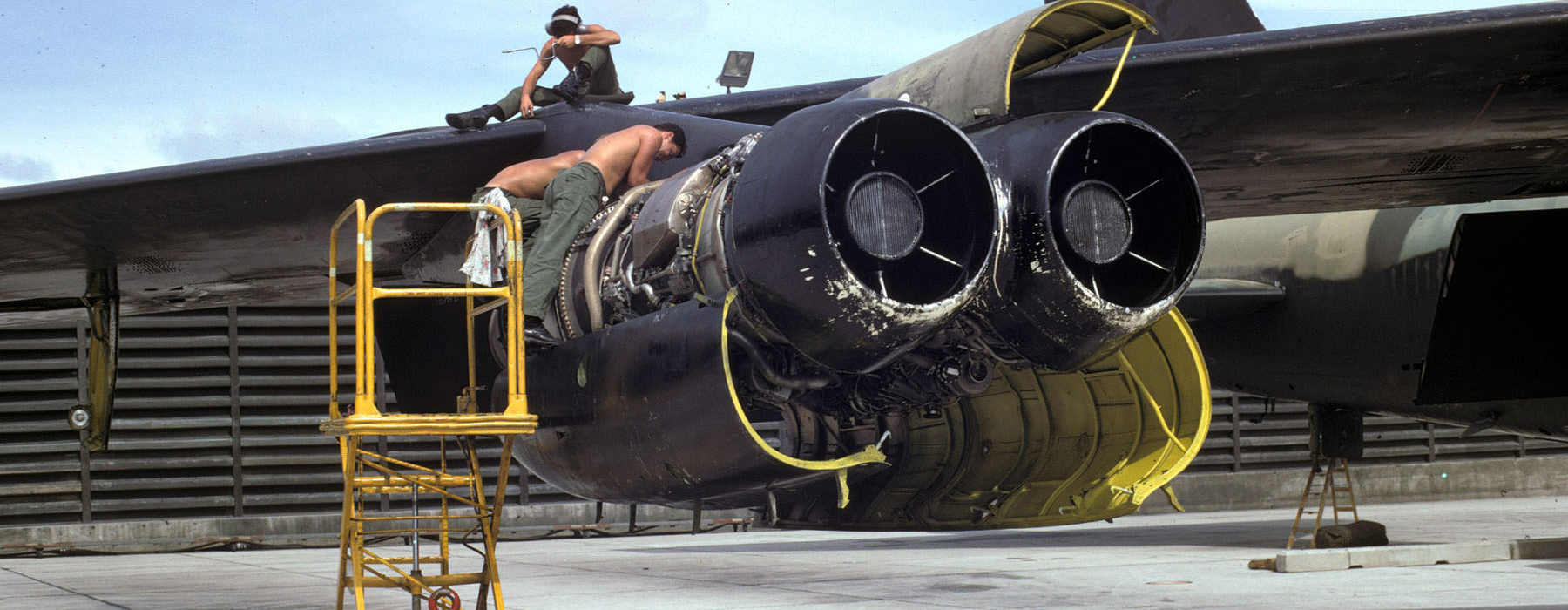In December 1972—40 years ago this month—the US executed Linebacker II, the largest B-52 bombing campaign of all time. The period from Dec. 18 to Dec. 29 saw the huge USAF bombers mount shattering strikes on North Vietnamese railways, airfields, surface-to-air missile storage sites, petroleum dumps, and other infrastructure targets around Hanoi.
 |
| Maintainers work on B-52 engines. They had to work day and night to keep the massive Lineback II offensive in the air. (USAF photo) |
B-52 crews flew 729 nighttime sorties. Their Air Force and Navy fighter escorts provided another 769 sorties for suppression of air defenses, combat air patrol against MiGs, escort, and chaff dispensing.
By the time the Linebacker II campaign was finished, North Vietnam was “on its knees,” in the words of National Security Advisor Henry A. Kissinger. It was ready and willing to sign a peace agreement that included the return of American prisoners of war.
The price was high. Communist defenses downed 15 B-52s, containing 92 bomber crew members. According to airpower historian Walter J. Boyne, eight of these airmen were killed in action or later died of their wounds. Twenty-five were missing in action. Thirty-three became prisoners of war. Only 26 were recovered alive before capture.
Linebacker II stemmed from the breakdown, in late 1972, of promising negotiations aimed at ending the Vietnam War.
The so-called Paris Peace Talks between Kissinger and North Vietnam’s Le Duc Tho had brought the sides close to agreement in October 1972. President Richard M. Nixon was so optimistic about the tentative peace agreement reached on Oct. 8, 1972, that, on Oct. 23, he suspended all US bombing north of the 20th parallel.
Not long afterward, however, Hanoi began to renege on its undertakings, and the peace talks moved toward collapse.
This infuriated Nixon, who vented his frustration in a Dec. 10, 1972, telephone conversation with Anatoly Dobrynin, the Soviet ambassador to the United States. (The recording was declassified in 2008.) “It’s … hard for me to understand how they can go back on what we had agreed on,” Nixon told Dobrynin. “[Soviet leader Leonid] Brezhnev and I, and your government, we got bigger fish to fry than this damn thing.”
To Nixon, “this damn thing” was the Vietnam War; the “bigger fish” was detente between the two superpowers, which the Vietnam War threatened to derail.
Nixon pressed the Soviet Union to put pressure on its belligerent client Hanoi. The tactic did not work. Gen. Alexander M. Haig Jr., the Army officer who was serving as deputy national security advisor, brought the bad news to Nixon on Dec. 12.
According to Dobrynin, said Haig, “Hanoi claims it’s Kissinger who’s intransigent and that there were many issues unresolved.” The Dobrynin message made it clear North Vietnam was in no hurry to resume talks or sign a treaty.
To break the logjam and extricate the US from the Southeast Asian quagmire, Nixon needed an extraordinary act, and he soon decided what it would be.
Nixon had already laid the groundwork for an air campaign option. On Nov. 30, 1972, he convened a White House meeting with the Joint Chiefs of Staff to discuss contingency plans. The original concept was for three to six days of B-52 strikes. The plans were to be put in motion if talks broke off or if talks succeeded but North Vietnam later violated the cease-fire agreement.
Nixon wanted a military action that would be, in his words, “massive and effective.” The President added, “Above all, B-52s are to be targeted on Hanoi,” North Vietnam’s capital city that had enjoyed sanctuary status for most of the war years.
All concerned in the planning knew that only overwhelming heavy bomber attacks could make a major difference in the delta during bad weather, historian Wayne Thompson wrote in his book To Hanoi and Back. Thus, Nixon believed he had one option left: to bomb prime military targets near Hanoi—and bomb them hard.
And We Can’t Do That
The Nixon Administration’s willingness to use the bomber weapon became apparent in a Dec. 12 Nixon-Haig conversation:
Nixon: “We’re not going to wait until the end of Christmas if we have to do the bombing.”
Haig: “No. … And if the talks break off or recess, I think we’ve got to really pick it up. We’ve got to put the heat on them. … They no sooner get a concession from us on an old issue like the DMZ [demilitarized zone] or our civilians then they pocket our concession and reopen the issue again to get another one.”
On Dec. 15, Nixon dictated to Kissinger a five-page, single-spaced memorandum, instructing him on what to say in a special press conference on Dec. 16.
 |
| Vietnamese soldiers and newsmen swarm over the wreckage of a US B-52 shot down just northwest of Hanoi, Dec. 18, 1972. (AP photo) |
Nixon wrote, “You should point out on the plus side that, as far as the war is concerned, as we enter this Christmas season, we can all be thankful that no draftees are going to Vietnam, that our casualties have been at either zero or near-zero levels for the last three months, that no Americans are engaged in ground combat, and that, for the first time since the war began, both sides are negotiating seriously to try to find a peaceful settlement.”
Nixon said that Kissinger “should also point out that the President insists that the United States is not going to be pushed around, blackmailed, or stampeded into making the wrong kind of peace agreement.”
Nixon, hashing over final details with Kissinger on that same day, reviewed American options.
“It’s been a long war,” said Nixon, as Kissinger listened. “We have to realize that there isn’t much else left to do unless you’re going to nuke them”—here, Nixon pauses—”and we can’t do that.”
Nixon continued, “What else is there to do then? We’ve done everything. They’ll say, talk to the Russians. We have. Talk to the Chinese? We have. Talk to the North Vietnamese? We have. Bomb them? We have. Mine them? We have.”
The Linebacker II operation kicked off on Dec. 18, 1972. The US position as cabled to Hanoi by Kissinger was that the North was “deliberately and frivolously delaying the talks.” If Le Duc Tho would agree to return to Paris, the US would cease bombing within 36 hours.
Control of the overall campaign was in the hands of USAF Gen. John C. Meyer, commander in chief, Strategic Air Command.
The risks of Linebacker II were hard to assess in advance. B-52 crews had been flying in the Vietnam War theater for years, with the loss of 13 aircraft. Each loss stemmed from an accident of some sort, save for one. On Nov. 22, 1972, a B-52D from U Tapao RTAB, Thailand, fell victim to a SAM blast.
Col. James R. McCarthy had recently taken command of the 43rd Strategic Wing on Guam. Large crowds of crew members packed in for three mass briefs.
McCarthy recounted in an Air Force monograph, “As the route was shown on the briefing screen, I said, ‘Gentlemen, your target for tonight is Hanoi.’ It must have been effective, because for the rest of the briefing you could have heard a pin drop.”
The pilots knew that, up north over Hanoi, the North Vietnamese had emplaced thick SA-2 air defenses and backed them up with anti-aircraft artillery. They were supplemented by a rejuvenated force of up to 145 fighters, including MiG-21s.
B-52s flew to waypoints to circle around the zone and penetrate from specific angles. Their chief protection from SAMs lay in chaff clouds dispensed by fighters, electronic jamming from escort aircraft, and electronic countermeasures from their own aircraft. Each BUFF carried four .50-caliber tail guns to deal with any MiG that might slip in behind.
On Night No. 1 of the campaign, a total of 129 B-52s from Guam and U Tapao attacked in three waves, but the communist SAMs proved deadly. The missiles claimed three B-52s plus one Navy A-7 attack aircraft and one F-111 lost for unknown reasons after its bomb run.
North Vietnamese MiGs suffered a loss, too. B-52D tail gunner SSgt. Samuel O. Turner shot down a MiG-21—scoring the first ever B-52 aerial victory.
Capt. Michael H. Labeau, a B-52 radar-navigator, belonged to an augmentee crew led by Capt. Robert J. Morris Jr., a pilot from Kincheloe AFB, Mich. Labeau flew a Night No. 2 mission from Guam. “It was not particularly dangerous,” Labeau judged. Their target that night was not right “downtown” and “we did not see a MiG.”
Disaster struck on Night No. 3. SAMs and MiGs blasted away at bomber formations. Six B-52s and an A-6 from USS Enterprise were shot down. Five B-52s were hit in post-target turns.
Maj. Dick Parrish that night was the radar-navigator in a B-52G in the final cell. The pilot and copilot saw one B-52 on fire and another explode from a direct hit. After bomb release and the turn for home the sky grew quiet.
Both pilots took one last look out the window just as two SAM indications popped up on the scope. “The next thing I knew,” said Parrish, “we were in a steep, descending right turn.”
The B-52 dove away as the SAMs exploded above them.
Two more B-52s were lost on Dec. 21. SAC was already implementing new tactics to change routes to the target. Because of losses, commanders also decided to redistribute some crews from Guam to U Tapao, Labeau said.
The crew from Kincheloe was among those rotated to U Tapao. Labeau flew again on Dec. 24 to hit a railroad target.
“At that time the railroads were not heavily defended,” said Labeau, but missiles still met them. “The North Vietnamese were trying to hit the lead airplane. They were still trying to radar-guide the missiles.”
In another B-52 that night was tail gunner TSgt. James R. Cook, who had flown numerous missions. Tail gunners scouted for MiGs and called out evasive maneuvers to defeat SAM shots, and the D model was best for this because of the visibility from the tail. In a mission on Dec. 24, three missiles came up, and Cook called them out. The B-52D dove to evade. They all scooted by the tail and exploded, Cook recalled.
Operations paused for Christmas Day. Planners and crew members prepared for maximum effort on Dec. 26. Plans called for seven streams of bombers to converge on Hanoi targets. As recalled by 1st Lt. Robert M. Hudson, who was a B-52 copilot on the raid, it was the night “we got bagged.”
The size of the Dec. 26 mission meant that the normal preflight activity was overloaded and confused.
“People were briefing in hallways,” Labeau remembered. “Targets were late, aircraft assignments were late, intelligence was late, the data you took out to the airplane with you was late,” he said.
Come on, Bob
 |
| President Nixon in 1972 speaks with South Vietnam’s President Nguyen Van Thieu on the steps of Saigon’s Independence Palace, the home and workplace of Thieu during the war. Behind them are (l-r) Henry Kissinger, South Vietnamese Vice President Nguyen Cao Ky, and Ellsworth Bunker, then ambassador to South Vietnam. (Photo via National Archives) |
Labeau’s crew, which included Morris and Hudson, was assigned to B-52D No. 56-0674 and briefed for the mission as Ebony 3. SAC kept the B-52s in formations of three to maximize coverage from the electronic countermeasures. The original Ebony 2 ground-aborted, and the Morris-Hudson-Labeau airplane moved up as call sign Ebony 2.
As Labeau recalled, “A lot of little things went wrong that in isolation wouldn’t have made a difference but in combination created the difference that we got hit.”
First, their regular tail gunner became incapacitated and Hudson called for a replacement. Cook had just finished his shift as the gunner assigned to wait on alert. All crews had briefed and stepped to their airplanes when the call came. “A truck came by to pick me up,” he said. “We started down the runway as I was strapping in.”
An engine fire warning lit up on takeoff. Ebony 2 circled over the Gulf of Thailand to get the engine pod shut down, and so now it was behind the other aircraft. Everything became rushed. Flying time from U Tapao to the target might take as little as 45 minutes.
The crew members never gave a thought to turning back, however. For one thing, they didn’t want tothey explained in recent interviews. For another, SAC had a “press on” rule, and the Ebony 2 crew knew that dropping out would eliminate all protection for their lead airplane.
Soon the SAMs were popping up. Intelligence reports had suggested the North Vietnamese might be nearly out of SAMs, but that obviously was not the case over Hanoi on Dec. 26.
“They were barrage firing all at one time,” said Labeau.
“It was apparent this was no F Troop doing the aiming,” said McCarthy, who was serving as the aircraft commander for the Dec. 26 mission.
Ebony 2 was coming in from the west and was vulnerable. Because it was part of a two-ship cell, “we stuck out,” said Labeau. Countermeasure defenses were lower with one less bomber, too.
Morris and Hudson watched for SAM launches. If a particular SAM’s flight path could be seen, it could be avoided, Hudson said. If a pilot saw a SAM on the left, they pushed the B-52 into a dive to the right, so as to make the SAM explode far above the aircraft. “The B-52 is much more maneuverable than you think,” Hudson remembered.
Just minutes out from the target, the crew scanned the sky for more SAMs and prepared the bomb run. However, they were down an engine, and they never did quite achieve the planned release airspeed. Procedure called for opening the bomb bay 60 seconds before the release point. Local tactics cut that to 30 seconds. Ebony 2’s slow airspeed delayed the bay opening even further.
As they approached the release point, Hudson and Morris didn’t see any SAM launches, but they had a blind spot. They didn’t see a SAM that came under the aircraft, recalled Hudson. At the last moment, the onboard electronic warfare officer, Maj. Nutter J. Wimbrow III, spotted something and declared calmly over the intercom, “We’re going to be hit.”
The SAM’s proximity fuse detonated its explosive payload on the left side of Ebony 2. The cockpit windows blew out. The radome was sheared away. Decompression sent objects flying around the crew spaces. Rushing air screamed through the crew spaces and made it hard to hear speakers on the intercom. Damage inside the cockpit was severe in the extreme.
Copilot Hudson looked over at the pilot, Morris. He had died instantly.
Radar-navigator Labeau came on the intercom, saying, “Come on, Bob, we’ve got to get the bombs off the airplane.”
Labeau was speaking to Morris, who was dead, and not copilot Bob Hudson. Still, Labeau’s sharp comment snapped Hudson out of his momentary shock, and he addressed the problem at hand.
Hudson got the crippled B-52’s nose up and turned the big bomber toward the target. Labeau was able to get all the bombs off and away and then directed the bomber south on a heading that was the quickest way out of trouble.
A second SAM hit.
“The whole plane bounced when that second hit came along,” said Cook, the tail gunner.
The B-52D rolled on its back.
“The decision was made to bail out,” said Labeau.
Downstairs in the aircraft, he and the navigator, 1st Lt. Duane P. Vavroch, sat side by side.
“We looked at each other,” recalled Labeau. “I said, ‘Get out!’ ” The navigator ejected. “There’s now a big hole beside me,” said Labeau.
He pulled the ejection handle. The hatch below opened, his seat swung a few degrees back—and nothing happened. Labeau found to his surprise that he was still in the B-52 with the seat stuck partway through the ejection sequence. He yanked on the black and yellow handles again.
“I don’t know how many times I pulled,” he said, “but it eventually shot me out of the airplane.”
Meanwhile, Cook was still in the tail. He’d disconnected his oxygen line and then blown the gun turrets away to open the bailout hatch, but he could not wriggle through the opening. Every time he tried, the parachute pulled him back into his seat. At over 30,000 feet, his oxygen ran out quickly. He passed out.
McCarthy, on another B-52, was departing the Hanoi area when he saw “a brilliant explosion” in the sky. It was Ebony 2, hit by a third SAM.
Amazingly, the force of the explosion blew tail gunner Cook out of the hulk of the bomber. He was unconscious, but his parachute opened automatically.
Hudson was also in his parachute but in trouble. The force of the ejection dislocated his hips, and he suffered broken ribs where he had not tightly fastened his straps. His mask had filled with blood from a blown-out sinus cavity. He tore the mask off to breathe. The clip banged and cut his face in the cold slipstream of air.
As he descended in his parachute, Hudson was shot in the left shoulder by riflemen on the ground. “They were waiting for me,” he said.
Because of the severity of the pain in his ribs and hips, Hudson did not notice his gunshot wound.
The End
For his part, Cook woke up in two feet of water, coughing. He was captured within minutes. He had suffered two broken legs, a broken back, and fractures in a shoulder and elbow. Soldiers wired his wrists and ankles together, put him in a motorcycle sidecar, and drove him to Hanoi.
Labeau and Hudson separately were picked up by villagers and turned over to North Vietnamese Army regulars.
In the “Hanoi Hilton,” the notorious prison used to hold captured American airmen, Labeau found he was one of the least injured of the new POWs. He spent the first week caring for about a dozen injured airmen, including navigator Vavroch, Air Force F-4 crew members, and Navy fliers.
At length, the imprisoned airmen noticed that the B-52 bombing attacks were no longer shaking the ground. “We were pretty sure that, once bombing stopped, something positive would happen,” said Hudson.
He was right. The air campaign of Linebacker II had forced the North Vietnamese to accept US terms and declare that Hanoi would soon return to the peace talks in Paris.
Cook, the Ebony 2 tail gunner, was repatriated; both legs were amputated and he was medically retired from the Air Force. Also returned were navigator Vavroch, copilot Hudson, and radar-navigator Labeau. The latter two recovered from their injuries and were retrained to fly the F-111. The remains of the pilot, Morris, and the crew’s electronic warfare officer, Wimbrow, were repatriated in 1977.
The Dec. 26 and Dec. 27 attacks marked the apex of Linebacker II. On Dec. 28, Kissinger called Nixon to tell him Hanoi had accepted the proposal to return to the peace table and get serious about an agreement.
Nixon: “No conditions?”
Kissinger: “No, it’s all of ours accepted.”
Nixon (later): “What significance do you attach to all this?”
Kissinger: “I think they are practically on their knees. … For them to accept this … is a sign of enormous weakness.”
Kissinger then noted that many critics in Washington were challenging the use of such heavy B-52 raids.
Nixon emitted one short, mirthless laugh.
“The main thing now, Henry, is we have to pull this [peace treaty] off. … My view is we talk and we settle.”
Within 34 hours of the conversation, the US declared Linebacker II to be at an end. On Guam, the last B-52 on the last raid landed just after noon, local time, on Dec. 30, 1972.
Peace talks resumed in Paris on Jan. 8, 1973. Cease-fire accords were signed on Jan. 27, 1973.
Shortly afterward, the US began bringing home its prisoners of war.
